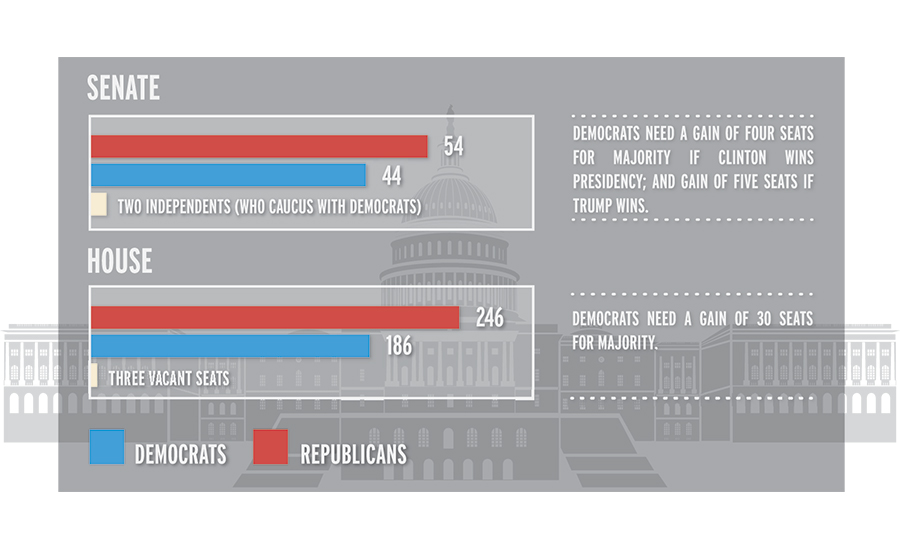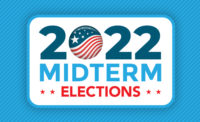Elections Likely to Produce Slim Majorities in Congress

Capitol Building courtesy of istockphoto.com / infographic by kaela torres/enr
As the Nov. 8 elections draw near, construction industry officials are keeping close watch on political parties’ fight for control of Congress. Forecasts at ENR press time suggest Democrats are likely to pick up several Senate seats—maybe enough for a slender majority—and some House seats, though probably not enough to dislodge Republicans’ hold there.
The shape of the next Congress will affect key construction measures in the next two years, including a Federal Aviation Administration authorization and appropriations for infrastructure programs. Also on the horizon may be debate on a major new public-works program, something presidential candidates Hillary Clinton and Donald J. Trump both have proposed.
But unless Senate Democrats or House Republicans post more wins on Nov. 8 than analysts predict, it’s unlikely that either will command wide enough majorities to dominate the flow of legislation. “Overall, the margins will be much, much tighter,” says Steve Hall, American Council of Engineering Companies vice president for government affairs. “It’s going to be a recipe, I think, for gridlock on many issues.”
If Trump wins the White House, a five-seat Democratic gain in the Senate would give the party a bare 51-49 majority there. If Clinton wins, a four-seat pickup would mean a 50-50 split but give Democrats Senate control, due to Vice President Tim Kaine casting the tie-breaking votes.
The Cook Political Report, the Rothenberg & Gonzales Political Report and Larry Sabato of the University of Virginia Center for Politics all rate about a half dozen Senate races as toss-ups. They include contests for Republican-held seats in Indiana, Missouri, New Hampshire, North Carolina, Pennsylvania and the Nevada seat held by retiring Democratic leader Harry Reid.
For the most part, construction associations and companies are strongly backing Republican candidates in those crucial races and building-trades unions and environmental groups are contributing heavily to Democrats. In Nevada, for example, construction groups have contributed about $179,000 to the Republican candidate, U.S. Rep. Joe Heck, according to the Center for Responsive Politics. The Democratic candidate, ex-Nevada Attorney General Catherine Cortez Masto, received $76,000 from construction unions and $213,000 from the League of Conservation Voters.
In the House, the GOP has a 246-186 edge, with three seats vacant. Forecasters say Democrats would need to add 30 seats to take over. The Cook Political Report projected that, as of Oct. 14, Democrats will gain between five and 20 seats there.
The campaigns’ bitter partisanship could spill over to Capitol Hill, tying up progress on a range of bills. Jeff Shoaf, Associated General Contractors of America senior executive director for government affairs, says, “I don’t have a whole lot of hope that there is going to be a lot of good will coming out of this election process. There’s not going to be a bipartisan flurry in the 115th Congress that’s going to get a lot of things accomplished.”
Hall hopes both parties will “look for issues that traditionally have been consensus issues, like infrastructure.” Brian Pallasch, American Society of Civil Engineers managing director for government relations, says, “It is certainly an area where there can be bipartisan agreement, hopefully even on finding solutions to fund some of our infrastructure.”
If Congress wraps up a new water- resources bill in the coming lame-duck session, the remaining 2017 infrastructure measures include appropriations and a new authorization for FAA, including airport construction grants. Action is needed by Sept. 30, when an FAA stopgap expires.
More intriguing is the potential for a big infrastructure initiative. Dave Bauer, American Road & Transportation Builders Association senior vice president for government relations, says, “The wild card is, how does this Congress respond to the candidates’ infrastructure call?”
Clinton has proposed a $275-billion, five-year boost for transportation, water and other sectors, including an infrastructure bank. She said that, if elected, she will send Congress a proposal in her first 100 days in office. Trump on Oct. 22 proposed a $1- trillion, 10-year “revenue-neutral” energy and infrastructure plan in his first 100 days.
But Shoaf says other issues are likely to consume the new Congress’s early weeks, such as Senate consideration of a nominee for a Supreme Court seat, vacant since Justice Antonin Scalia’s death in February. Also on tap are confirmation hearings for the new president’s Cabinet. With that busy docket, Shoaf adds, “I don’t know how you squeeze a big construction agenda into there.”





